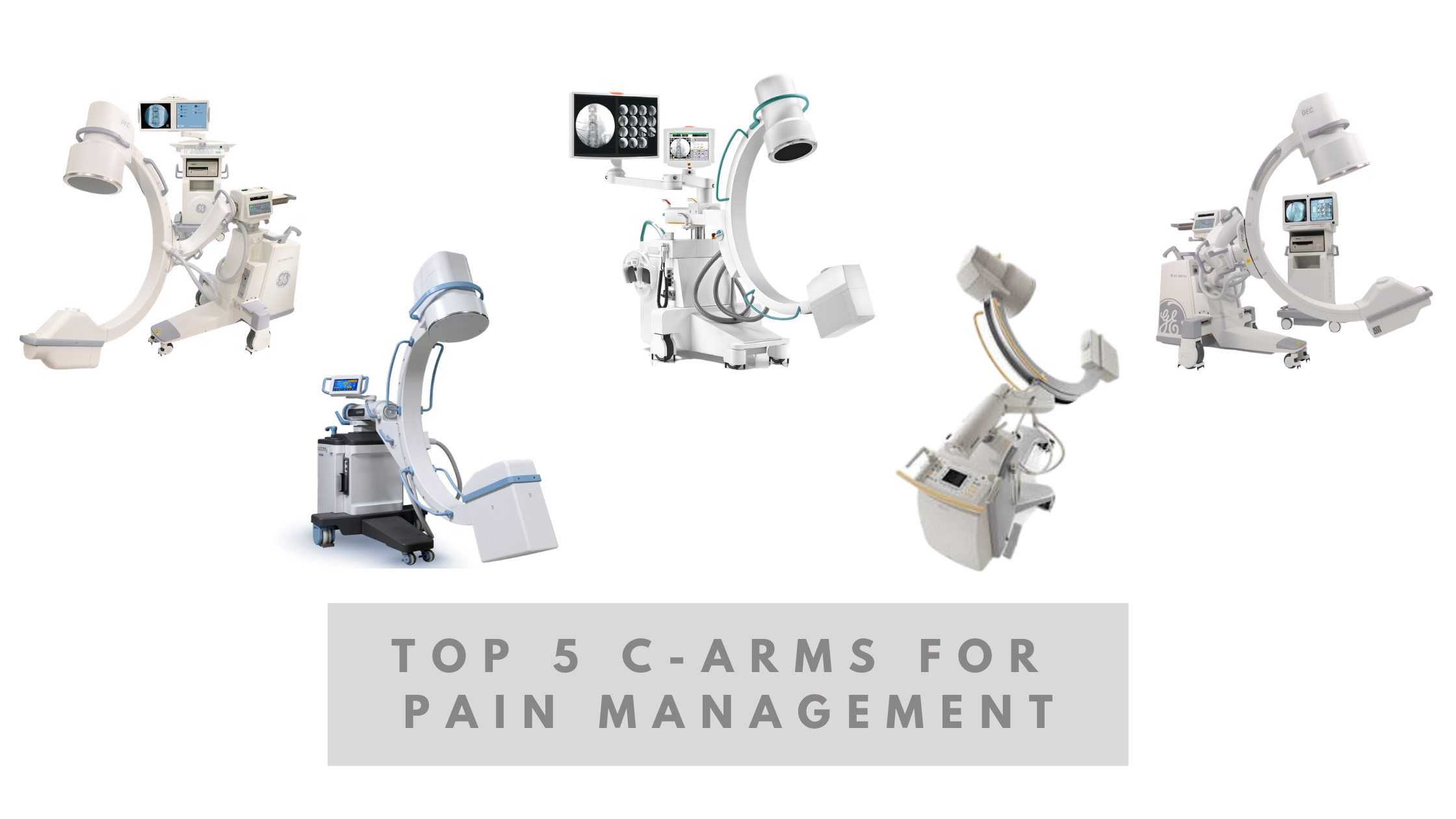Starting a new pain management practice and starting to look at equipment? Or are you needing a new C-Arm for your existing practice? Choosing among the various makes, sizes, feature sets, and options can be a daunting experience. It’s hard to pull out the information you need from all the specification noise. Have no fear, though, we’re here to help!
We’ve selected the five C-Arms that, in our experience working with hundreds of pain management specialists, are the most useful and popular among the doctors we’ve talked with. But we’re not just going to bombard you with a bunch of specifications for you to wade through.
We’ll start by discussing three considerations that have a direct impact on your practice. Armed with this insight, making a choice becomes easier. Then we’ll focus on the relevant specs for the machines we’ve selected so you aren’t exposed to ‘spec overload.’
Considerations for Pain Management
Image Intensifier (II)—9” or 12”?
Several of our picks have options for either size. The fact that all of them have a 9” II tells you a bit about how popular the 9” is.
Both IIs are ‘3-step’ IIs, meaning they can be collimated down to reduce the field of view and increase magnification. A 12” II’s three steps are 12”, 9”, and 6” whereas the 9” II’s three steps are 9”, 6”, and 4.5.”
A 12” II gives you a larger field of view in 12” mode, which is handy when you need to see the ‘lay of the land’ as it were. But a larger field of view means lower magnification, resulting in less detail. The 9” II in 9” mode gives you the same field of view as a 12” in 9” mode and thus higher initial magnification. In 4.5” mode, the 9” II has the smallest field of view, but the largest magnification, useful when greater detail is critical to your procedure.
Does Depth and Orbital Rotation Really Matter?
The depth of the C-Arm is the distance between the back of the ‘C’ and the path of the x-rays between the x-ray source and the image intensifier. A deeper C-Arm gives you more flexibility in positioning, especially when performing lateral imaging with the ‘C’ under the table. For example, the spine of a larger patient in the prone position is further away from the table, necessitating that the C-Arm be raised to compensate. Shallower C-Arms may not be able to accommodate this positioning.
The orbital rotation of the C-Arm is how far the C-Arm travels in its arc. Greater rotation gives you more positioning flexibility. A C-Arm with greater overcast gives you the ability to perform diagonal (oblique) imaging without having to move the C-Arm table, making the whole process easier and more efficient.
Stationary or Rotating Anode?
The anode takes the energy from the cathode and turns into the x-rays that create the image in the image intensifier. That energy is intense, and, if it strikes the anode
unevenly, absorbing it over a long period of time can misalign a stationary anode. A rotating anode, which continually changes which portion of the anode receives any
potential uneven energy, can run for longer periods and at higher doses. The choice here depends on the procedures you perform. If your procedures require longer exposures or higher doses, having a rotating anode is obvious. Otherwise, a stationary anode will do.
The Top 5 Machines for Pain Management
GE OEC 9900 – Industry Standard, Easy Of Use, Easy To Service
- Image Intensifier: 9” or 12”
- C Depth: 9” II: 26”; 12” II: 28”; Super C: 33”
- Orbital Rotation: 9” or 12” II: 115˚ (25˚ overcast); Super C: 145˚ (55˚overcast)
- Anode: Rotating
- LEARN MORE
Genoray Zen-7000 – Best NEW C-Arm Value
- Image Intensifier: 9” or 12”
- Orbital Rotation: 135˚ (45˚ overcast)
- C Depth: 26.77”
- Anode: Rotating
- LEARN MORE
Ziehm Solo – Best Compact C-Arm
- Image Intensifier: 9”
- Orbital Rotation: 135˚ (45˚ overcast)
- C Depth: 26.77”
- Anode: Stationary
- LEARN MORE
GE OEC 9800 – Lower Cost Option To The 9900, Easy Of Use, Easy To Service
- Image Intensifier: 9” or 12”
- C Depth: 26” Super C 33”
- Orbital Rotation: 9” or 12” II: 115˚ (25˚ overcast); Super C: 145˚ (55˚
overcast) - Anode: Rotating
- LEARN MORE
Philips Pulsera – Lower Cost Option, Comparable To GE Systems.
- Image Intensifier: 9” or 12”
- Orbital Rotation: 135˚ (45˚ overcast)
- C Depth: 24”
- Anode: Rotating
- LEARN MORE
Choosing a great machine for your pain management practice doesn’t have to be complicated. Knowing what procedures you’re going to perform, having a grasp of the features that most affect those procedures, and knowing your budget, allows you to narrow down your choices pretty quickly. We hope this article has been helpful to you as you make your choice. Let us know by commenting below.
Our sales team is experienced in guiding pain management specialists to the machine that makes the most sense for their practices. If you’re still not sure, you want to look at manufacturers and models not covered here, or you have additional questions, contact us by phone or by using the information form below. You’ll be glad you did.

